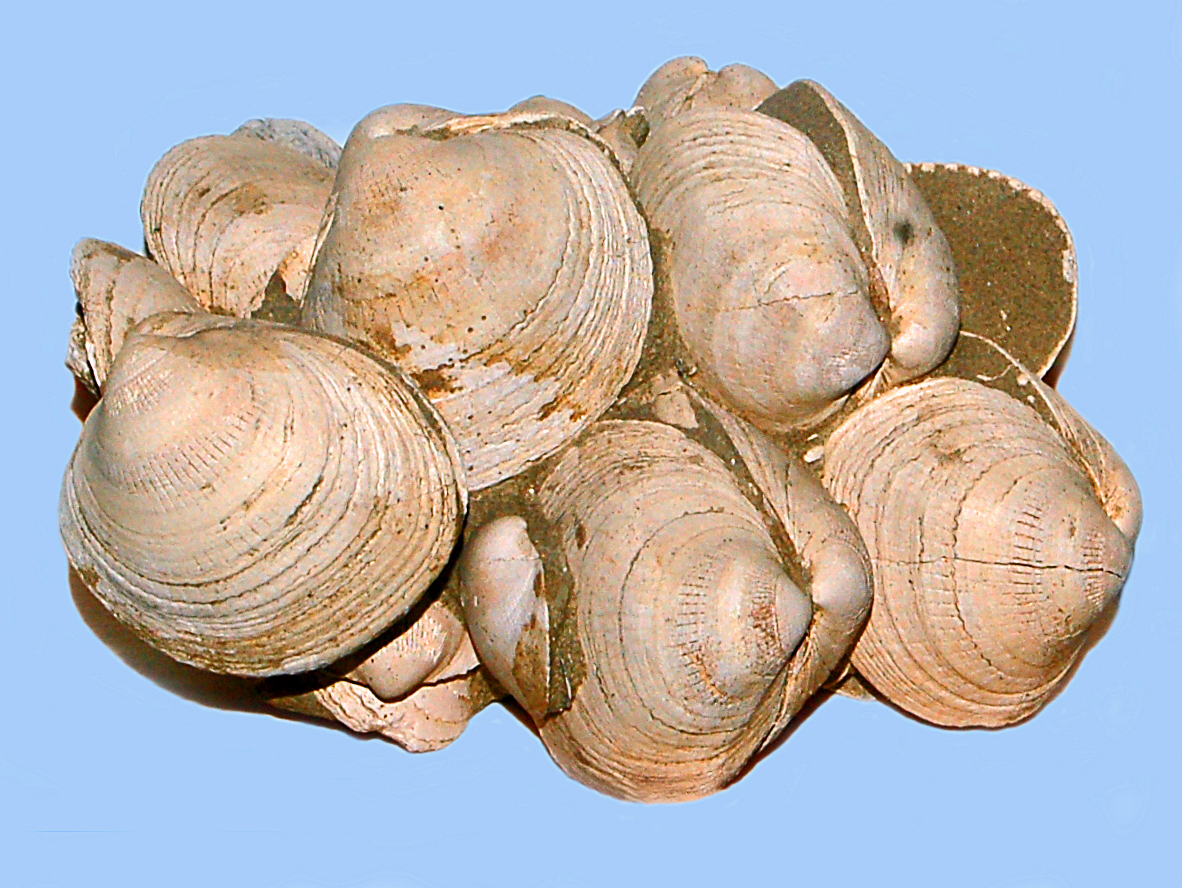Catedral de Cádiz (piedra ostionera) EarthCache
Catedral de Cádiz (piedra ostionera)
-
Difficulty:
-

-
Terrain:
-

Size:  (other)
(other)
Please note Use of geocaching.com services is subject to the terms and conditions
in our disclaimer.

 Cathedral of Cádiz. Oyster stone
Materiales
Cathedral of Cádiz. Oyster stone
Materiales
Se conoce como piedra ostionera el tipo de roca constituida a partir de distintos materiales, (Glycymeris sp. Ostrea edulis y Pecten sp.) entre los que son visibles areniscas y restos de animales marinos fosilizados (conchas y cáscara de distintos moluscos, fundamentalmente).
Este tipo de piedra, característica de la costa gaditana del entorno de la Bahía se extrae en cantera a cielo abierto en zonas próximas a la propia costa, donde es muy fácil verla a lo largo de playas como en las de Cádiz, San Fernando, Sancti Petri o La Barrosa, en Chiclana de la Frontera, entre otras.
La presencia de conchas marinas corrobora el origen de estas rocas en el fondo del mar, aunque hoy se encuentra buena parte de ella emergida y a simple vista, incluso a mucha distancia de la costa, donde hoy ya no hay mar, pero sí lo hubo cientos o miles de años atrás.
Glycymeris

De Hectonichus - Trabajo propio, CC BY-SA 3.0, https://commons.wikimedia.org/w/index.php?curid=19663932
Ostrea edulis

Pecten

By Hectonichus - Own work, CC BY-SA 3.0, https://commons.wikimedia.org/w/index.php?curid=41185717
Mapa de materiales
Todo el entorno de Cádiz corresponde a materiales postorogénicos.
Los materiales que afloran en Cádiz y en las localidades cercanas son conglomerados, arenas, margas y limos. En la imagen siguiente podemos observar la distribución de los mismos.
Las canteras de donde se han extraído los materiales de construcción de las fortalezas se encuentran ubicadas en el municipio de Puerto Real, ubicadas en los materiales correspondientes a Conglomerados, arenas, lutitas y calizas.
Piedra ostionera
Bien labrada constituye un elemento constructivo de gran belleza por su color y textura. Con ella se han construido gran cantidad de obras en ciudades como Cádiz, San Fernando, Puerto Real, El Puerto de Santa María o Chiclana de la Frontera; una zona de marismas donde escasean las canteras convencionales y donde los transportes terrestres han sido particularmente difíciles tradicionalmente.
Sus diferentes tonos de marrón -que van del color miel al marrón oscuro-, su aspecto muy poroso, su peculiar textura, y la presencia de conchas en su superficie, la hace inconfundible a simple vista.
En edificios importantes se presenta bien labrada en bloques ortogonales (sillares), generalmente en las plantas inferiores de fachada a modo de zócalo de base, que se deja vista a propósito (sin revestimiento posterior), ennobleciendo así esta zona del edificio. Por su alta resistencia su uso es muy acusado en elementos singulares como murallas y baluartes, torres de iglesias o portadas de casas de cierta importancia.

Muy usada tradicionalmente en edificios militares, civiles y religiosos en los siglos XVIII y XIX, actualmente -y debido a su alto coste- se usa más cortada en placas delgadas, como revestimiento superficial de zócalos y en portadas de edificios.
El nacimiento de esta ciudad se debe, formal y geométricamente, a la emergencia en el Plioceno Inferior, hace ya casi 2,5 millones de años, sobre estratos líticos de una arenisca calcarenita denominada zoomórfica, nuestra doméstica piedra ostionera. Llamada así por incluir junto con su amalgama de arena y calcita, restos calcáreos de los habitantes marinos que la poblaron antes del plegamiento, que las hizo surgir al aire.
Nuestra querida piedra marina es el soporte estructural y vital de todo nuestro urbanismo y de la mayor parte de nuestra arquitectura histórica. Siempre extraída, huellas quedan en La Caleta, para ser utilizada como material de construcción.
Rocas sedimentarias
Las rocas sedimentarias son rocas que se forman por acumulación de sedimentos, los cuales son partículas de diversos tamaños que son transportadas por el agua, el hielo o el viento, y son sometidas a procesos físicos y químicos (diagénesis), que dan lugar a materiales consolidados. Las rocas sedimentarias pueden formarse a las orillas de los ríos, en el fondo de barrancos, valles, lagos, mares, y en las desembocaduras de los ríos. Se hallan dispuestas formando capas o estratos.
Existen procesos geológicos externos que actúan sobre las rocas preexistentes, estos agentes las meteorizan, transportan y depositan en diferentes lugares dependiendo del transporte (agua, viento, hielo). De igual manera, distintos organismos animales o vegetales pueden contribuir a la formación de rocas sedimentarias (fósiles). Las rocas sedimentarias pueden existir hasta una profundidad de diez kilómetros en la corteza terrestre. Estas rocas pueden presentarse sueltas o consolidadas, es decir, que han sido unidas a otras por procesos posteriores a la sedimentación, conocidos como diagénesis.
Las rocas sedimentarias cubren más del 75 % de la superficie terrestre, formando una cobertura sedimentaria que se encuentra sobre rocas ígneas y, en menor medida, en metamórficas. Sin embargo su volumen total es pequeño cuando se comparan sobre todo con las rocas ígneas, que no solo forman la mayor parte de la corteza, sino la totalidad del manto.
 El Earthcache
El Earthcache
Por favor no incluyas fotos del lugar de las coordenadas en tu log o será retirado. Si tiene cualquier duda puede contactar por la web de geocaching.com
Espero aprenda algo mas sobre la geología de Cádiz y aprenda a diferenciar éste tipo de roca en cualquier lugar.
No es necesario esperar la respuesta del propietario para hacer found, una vez enviadas las respuestas yo comprobaré y me pondré en contacto con usted.
Preguntas:
En el lugar de las coordenadas se puede observar en la fachada un rectángulo formado por sillares.
1.- ¿Son del mismo color que el resto?
2.- ¿De que color son los sillares del rectángulo?
3.- ¿Que tipo de piedra estámos viendo?
4.- ¿Cuantos sillares forman el rectángulo?
5.- ¿Cuánto miden los sillares mas grandes?
Ahora acércate a la fachada, cuenta 8 sillares desde el suelo hacia arriba, observa el que está mas a la derecha.
6.- ¿Que tipo de fósil estas viendo?
7.- ¿Cuánto mide el fósil de arriba a abajo?
Muchas gracias por visitar este earthcache. Feliz Geocaching!!!!


 Cathedral of Cadiz. Oyster stone
Cathedral of Cadiz. Oyster stone
materials
It is known as stone ostionera the type of rock formed from different materials ( Glycymeris sp. Ostrea edulis and Pecten sp. ), among which are visible sandstone and fossilized marine animals ( shells and shell of different molluscs , mainly) .
This type of stone , characteristic of the Cadiz coast around the bay is extracted in quarry opened in areas close to the coast itself , where it is very easy to see along beaches in Cadiz , San Fernando , Sancti sky Petri and La Barrosa , in Chiclana de la Frontera , among others.
The presence of seashells corroborates the origin of these rocks on the seabed , although today it is much of it landmass and at first sight , even at a great distance from the coast, where today there is no sea, but it was hundreds or thousands of years ago.
Glycymeris

De Hectonichus - Trabajo propio, CC BY-SA 3.0, https://commons.wikimedia.org/w/index.php?curid=19663932
Ostrea edulis

Pecten

By Hectonichus - Own work, CC BY-SA 3.0, https://commons.wikimedia.org/w/index.php?curid=41185717
Map of materials
The whole environment of Cádiz corresponds to orogenic materials.
The materials outcropping in Cadiz and in the nearby villages are conglomerates , sands , loams and silt . In the next picture we see the distribution of them .
The quarries from which were extracted building materials strengths are located in the municipality of Puerto Real, located in the corresponding Conglomerates materials, sands , shales and limestones .
 stone oyster
stone oyster
Well carved constitutes a constructive element beauty of its color and texture. With it have built many works in cities like Cadiz, San Fernando, Puerto Real, El Puerto de Santa María and Chiclana de la Frontera; an area of marshland where few conventional quarries and land transport where traditionally have been particularly difficult.
Its various shades of brown honey-ranging from dark-brown color, very porous their appearance, their peculiar texture, and the presence of shells on the surface, makes it unmistakable eye.
In important buildings it is presented well carved in orthogonal blocks (blocks), usually on the lower floors facade as a socket base, which purposely left view (without further coating) and ennobling this area of the building. Because of its high resistance use is very pronounced in unique elements such as walls and ramparts, towers of churches or houses covers some importance.
 Very traditionally used in military, civil and religious buildings in the eighteenth and nineteenth centuries, at present and because of its high cost-plus cut into thin plates used as a surface coating of sockets and covers buildings.
Very traditionally used in military, civil and religious buildings in the eighteenth and nineteenth centuries, at present and because of its high cost-plus cut into thin plates used as a surface coating of sockets and covers buildings.
The birth of this city must formally and geometrically, the emergence in the Pliocene, and almost 2.5 million years ago, on lithic sandstone strata of a calcarenita called zoomorphic, our domestic oyster stone. Named for include with its mix of sand and calcite, calcareous remains of marine inhabitants that populated before folding, which gave rise to the air.
Our beloved marine stone is the structural and life support of all our planning and most of our historical architecture. Always extracted, footprints left in La Caleta, to be used as construction material.
Sedimentary rocks
Sedimentary rocks are rocks formed by the accumulation of sediments, which are particles of various sizes that are transported by water, ice or wind, and are subjected to physical and chemical processes (diagenesis), which give rise to material consolidated. Sedimentary rocks can be formed on the banks of rivers, deep canyons, valleys, lakes, seas, and in the mouths of rivers. They are arranged in layers or strata.
There are external geological processes acting on preexisting rocks, these agents of weathering, transported and deposited in different places depending on the transport (water, wind, ice). Similarly, various animal or plant organisms can contribute to the formation of sedimentary rocks (fossil). Sedimentary rocks can exist to a depth of ten kilometers in the Earth's crust. These rocks may be present loose or consolidated, namely, which they have been bonded to other by known post-sedimentation processes such as diagenesis.
Sedimentary rocks cover more than 75% of the earth's surface, forming a sedimentary cover located on igneous rocks and to a lesser extent, metamorphic. However its total volume is small when compared especially with igneous rocks, which not only make up most of the crust, but the entire mantle.
 the EarthCache
the EarthCache
Please do not include photos of the place of the coordinates in your log or be removed. If you have any questions you can contact the website geocaching.com
I hope to learn something more about the geology of Cádiz and learn to differentiate this type of rock anywhere.
No need to wait the owner's answer to found, once sent the answers I'll check and I will contact you.
Questions:
In place of the coordinates can be observed in the facade formed by a rectangle blocks.
1. Are the same color as the rest?
2. What color are the building blocks of the rectangle?
3. What kind of stone are seeing?
4. How many blocks form the rectangle?
5. How long are the biggest stones?
Now approach the facade, has eight blocks from the ground up, observes that it is more to the right.
6. What kind of fossil viewing?
7. How long is the fossil from top to bottom?
Thank you very much for visiting this EarthCache. Geocaching happy !!!!
Additional Hints
(Decrypt)
Arprfvgnf han pvagn zégevpn cnen ernyvmne ynf gnernf/Lbh arrq n gncr zrnfher gb cresbez gnfxf